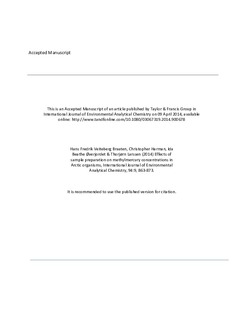| dc.contributor.author | Braaten, Hans Fredrik Veiteberg | |
| dc.contributor.author | Harman, Christopher Peter | |
| dc.contributor.author | Øverjordet, Ida Beathe | |
| dc.contributor.author | Larssen, Thorjørn | |
| dc.date.accessioned | 2019-01-03T15:29:36Z | |
| dc.date.available | 2019-01-03T15:29:36Z | |
| dc.date.created | 2014-11-25T21:55:49Z | |
| dc.date.issued | 2014 | |
| dc.identifier.citation | International Journal of Environmental Analytical Chemistry. 2014, 94 (9), 863-873. | nb_NO |
| dc.identifier.issn | 0306-7319 | |
| dc.identifier.uri | http://hdl.handle.net/11250/2579075 | |
| dc.description.abstract | The biogeochemical cycling of mercury (Hg) in the marine environment is an issue of global concern, as consumption of marine fish is a major route of human exposure to the toxic specie methylmercury (MeHg). The most widely utilised and accepted technique for preparing biological tissue samples for the analysis of MeHg involves an alkaline digestion of the sample. Recent studies suggest, however, that this technique is inadequate to produce satisfactory recoveries for certain biological samples, including fish, fur, feathers and other ‘indicator’ tissues which contain relatively high levels of MeHg. Thus an improved acidic extraction method has been proven to produce more satisfactory results for a wide range of biological tissues. The present study compares the two methods on real sample material from different organisms of an Arctic marine food chain, and shows how this could lead to misinterpretation of analytical results. Results show significantly (p < 0.05) lower concentrations for alkaline digestion for large parts of the food chain; especially in fish and birds. The mean differences in concentrations found between the two different methods were 28, 31 and 25% for fish (Polar and Atlantic cod), Little Auk and Kittiwake, respectively. For samples lower in the food chain (i.e. zooplankton and krill) no significant differences were found. This leads to a clear underestimation of the levels of MeHg found higher up in these food chains; the ratio of MeHg to Hg in biological samples; and thus potentially erroneous conclusions drawn from these results concerning the biological cycling of mercury species. We hypothesise that the main reasons for these differences are poor extraction efficiency and/or matrix effects on the ethylation step prior to analysis. This is the first study to examine the effects of these artefacts on real environmental samples covering a complete food chain. | nb_NO |
| dc.language.iso | eng | nb_NO |
| dc.publisher | Taylor & Francis | nb_NO |
| dc.title | Effects of sample preparation on methylmercury concentrations in arctic organisms | nb_NO |
| dc.type | Journal article | nb_NO |
| dc.type | Peer reviewed | nb_NO |
| dc.description.version | acceptedVersion | nb_NO |
| dc.source.pagenumber | 863-873 | nb_NO |
| dc.source.volume | 94 | nb_NO |
| dc.source.journal | International Journal of Environmental Analytical Chemistry | nb_NO |
| dc.source.issue | 9 | nb_NO |
| dc.identifier.doi | 10.1080/03067319.2014.900678 | |
| dc.identifier.cristin | 1177072 | |
| dc.relation.project | Norges forskningsråd: 196295 | nb_NO |
| cristin.unitcode | 7464,30,12,0 | |
| cristin.unitcode | 7464,20,12,0 | |
| cristin.unitcode | 7464,30,0,0 | |
| cristin.unitname | Akvatiske miljøgifter | |
| cristin.unitname | Marin forurensning | |
| cristin.unitname | Fagsenter for ferskvannsmiljø | |
| cristin.ispublished | true | |
| cristin.fulltext | postprint | |
| cristin.qualitycode | 1 | |
